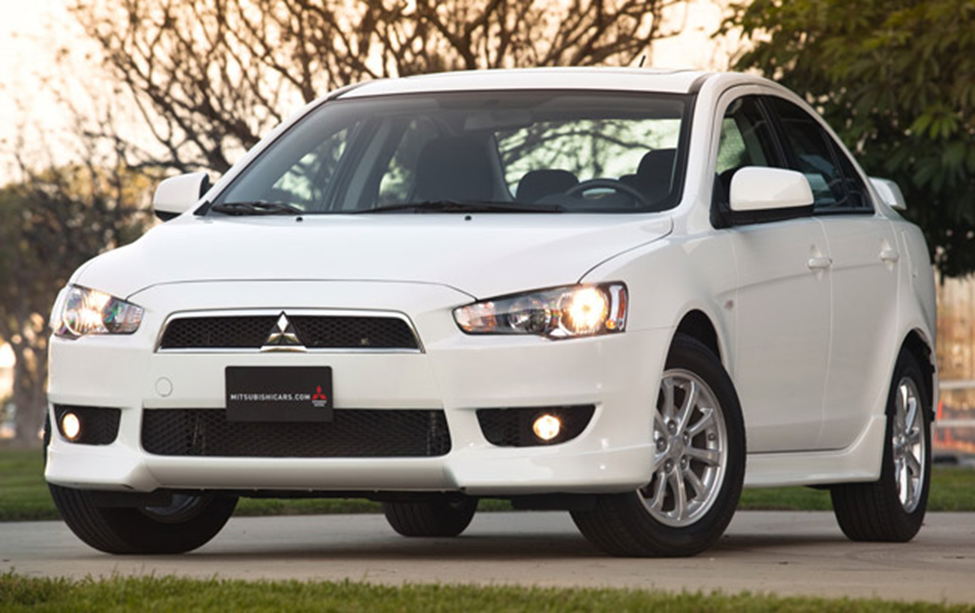The 5-seat Lancer comes in two distinct body styles, with a few engines options and a couple of trim levels for each. Lancer ES models are powered by a 2.0L 4-cylinder, producing 152 hp and mated to a standard 5-speed manual or an available continuously variable transmission (CVT).
The base Lancer ES comes with plenty of features, such as power windows, doors and mirrors, a 140-watt AM/FM/CD/MP3 stereo with speed-compensated volume and equalization control, remote keyless entry and anti-theft immobilizer, a 12-volt power outlet, anti-lock brakes, passenger and driver airbags, a knee airbag and side-impact airbags.
The SE Lancer comes with all-wheel drive and the CVT transmission only. It gets alloy wheels, an upgraded stereo with a 6-inch touchscreen interface and Bluetooth, and heated front seats.
The GT and SE come with a 2.4L 4-cylinder engine, which delivers 168 hp. The GT also gets 18-inch alloy wheels, an upgraded stereo with a touchscreen interface and SiriusXM satellite radio, proximity entry and automatic climate control.
The Lancer Ralliart gets a mild turbocharged version of the 2.0L engine. It aims to deliver the practicality of the basic Lancer with some of the fun-to-drive performance of its bigger brother, the Evolution. The Ralliart gets 237 hp and 253 lb-feet of torque. That power is put to all four wheels through Mitsubishi’s advanced, rally-inspired Twin Clutch-Sportronic Shift Transmission (TC-SST). The Ralliart includes fog lights, rear spoiler, sport-tuned suspension, 18-inch alloy wheels and a limited-slip differential at both the front and the rear. The Ralliart is also available with a couple of nice options, including a 710-watt Rockford-Fosgate system, a navigation system and Recaro sport seats.
The Lancer Sportback is the wagon variant. Available trimmed similar to the sedan ES and GT trims, designers kept functionality in mind as much as sportiness and gave it a cargo floor that can be lowered three inches for more space and a rear door that extends all the way to the bumper for loading heavy or cumbersome gear.
The top-of-the-performance-heap Lancer Evolution is an impressive performance sedan by any measure. It features a 2.0L turbocharged 4-cylinder engine that makes 291 horsepower and 300 lb-feet of torque, front and rear limited-slip differentials and a high-tech electronically controlled center differential. Mitsubishi used its knowledge and experience on the rally circuit to perfect the computer-controlled all-wheel drive system found in the Evolution and the result is impressive levels of control and safety even at high speed. The Lancer Evolution is available with either a 5-speed manual transmission or a twin clutch 6-speed. The Evo comes in two trims, a base GSR and an uplevel TC-SST MR.
The Evolution is well-enough equipped, but as a nod to its stripped-down razor-sharp racecar aesthetic, the car comes relatively spartan, given its price point. The GSR Evo does, however, come with 18-inch Enkei alloy wheels wrapped in Yokohama ADVAN performance tires, lightweight aluminum body panels, a large rear spoiler, fog lamps, active stability control, anti-lock brakes, Recaro seats and automatic climate control.
The MR comes with a 6-speed dual-clutch transmission, Eibach springs and Bilstein shocks, HID headlamps and BBS forged alloy wheels.
The Sight and Sound package adds a proximity entry system and a Rockford-Fosgate stereo. A Touring package adds leather seat trim, a chrome grille, rain sensing wipers, heated mirrors and a power sunroof. Navigation and interior LED illumination are also available as installed accessory options.



